Welcome at part #8 of the series ’10 lessons learned from a true Horseman’. In the last article you read about the importance of getting a good foundation before you go for higher level exercises things that ask more of the relationship with your horse. In this article I will talk about something that is a humongous part of that relationship; the connection your horse feels with your (and you with him).
 When we invited Berni Zambail to come as a guest instructor at the NH Experience 2015 more than a year ago I was wondering about some of the things I expected to happen that he usually has people do during his teaching. One of those things is what you could call the ‘connection test’. And it did show up.
When we invited Berni Zambail to come as a guest instructor at the NH Experience 2015 more than a year ago I was wondering about some of the things I expected to happen that he usually has people do during his teaching. One of those things is what you could call the ‘connection test’. And it did show up.
This is how it works: you let your horse go, or put your rope over his back and then just calmly walk away (without giving him a cue to do something specific). If he immediately follows you… goal accomplished! You had a connection with him and he was thinking about you. From you speed he follow you, how long he follows you and how much effort he puts into being with you, you can tell the strength of the connection. You can see where, if he would just stay put…there would still be a couple of holes to fill.
Of course there are many excuses to think of when your horse doesn’t follow you, or responds slowly. He was distracted, he wasn’t sure what you wanted or maybe you even taught him to stay put when you walk away. But most of these excuses are exactly that…. excuses.
You only realize this when you see a true Horseman with a horse that he only just met. The horse seems to be in love with him. It’s constantly paying attention to him and is always ready to respond.
in love with him. It’s constantly paying attention to him and is always ready to respond.
It’s something that I’ve seen Berni, and several other good Horseman, get time and time again. And really is ‘just like magic’.
Naturally this state of connection shouldn’t mean that your horse is always nervously waiting or acts like a slave ready to respond to a command. And if you’ve seen a duo like I just described; ‘The Horse & man’ you know it’s possible to get this without losing the horses dignity.
A good connection means attentiveness or alertness but also trust. Trust that when the human partner says something is alright, it really is, but also trust that there is room for mistakes. The horse knows that his partner knows him and trusts that he will do his very best, but also trusts that his partner won’t ask him for anything he cannot do. If this go’s hand in hand with respect from both ways, and some play, you get this wonderful bond.
But how do I get this connection?
Unfortunately it’s not even that easy to explain in words but it comes down to the following: use psychology in your training.
 Make sure that you keep asking your horse questions and are open to his feedback; don’t just give him a job and ignore him after you’ve given him the command. Show him that if he does give you feedback, you’ll use it. Create a feeling of working together instead of you working your horse. Ask him to explore new things, things that require him moving his brain instead of just his body. And be ready to adjust to the type of behavior he is showing in any moment (because it will change from moment to moment…with some horse more subtle than with others, but it’s there). The better you learn to adjust and show him that you understand him and want the same things (4 basic needs), the sooner he will start seeing you as his partner.
Make sure that you keep asking your horse questions and are open to his feedback; don’t just give him a job and ignore him after you’ve given him the command. Show him that if he does give you feedback, you’ll use it. Create a feeling of working together instead of you working your horse. Ask him to explore new things, things that require him moving his brain instead of just his body. And be ready to adjust to the type of behavior he is showing in any moment (because it will change from moment to moment…with some horse more subtle than with others, but it’s there). The better you learn to adjust and show him that you understand him and want the same things (4 basic needs), the sooner he will start seeing you as his partner.
So this week, when you’re playing with your horse, check out how often he asks you questions, with his ears eagerly pointed at you, and try to answer them. Don’t ignore those moments when he’s trying to make contact.
You’ll see that when you do this; leave room for communication and feedback, your horse will want to be with you more and more and give you more than you ever asked for!
Lees je het artikel liever in het Nederlands? Hieronder vind je het origineel—> Continue reading






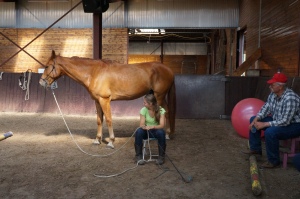
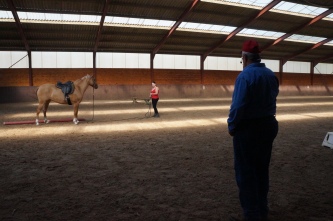

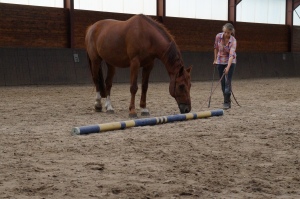
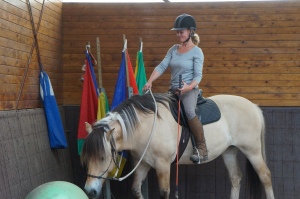




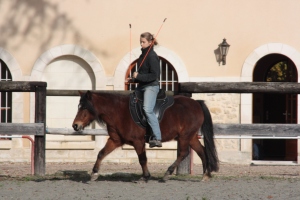


 Begin november j.l heb ik de mogelijkheid aangenomen om een week in Zwitserland (Kleindöttingen) te verblijven op de prachtige locatie van
Begin november j.l heb ik de mogelijkheid aangenomen om een week in Zwitserland (Kleindöttingen) te verblijven op de prachtige locatie van 